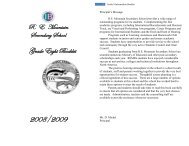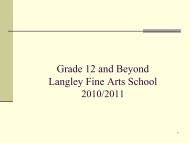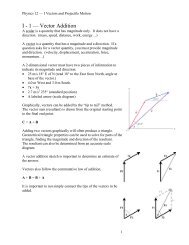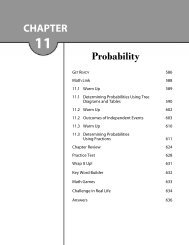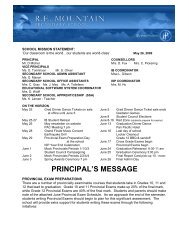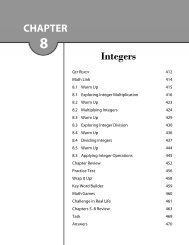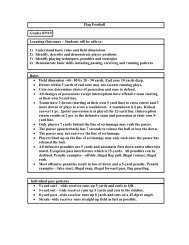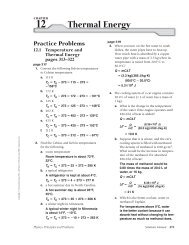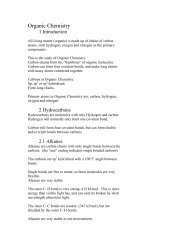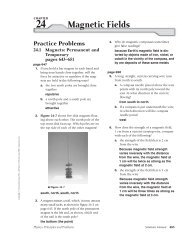Physics Solutions Manual
Physics Solutions Manual
Physics Solutions Manual
You also want an ePaper? Increase the reach of your titles
YUMPU automatically turns print PDFs into web optimized ePapers that Google loves.
Chapter 15 continued<br />
f 2 2f 1 (2)(370 Hz) 740 Hz<br />
f 3 3f 1 (3)(370 Hz) 1110 Hz<br />
1100 Hz<br />
f 4 4f 1 (4)(370 Hz) 1480 Hz<br />
1500 Hz<br />
26. Resonance in Closed Pipes One closed<br />
organ pipe has a length of 2.40 m.<br />
a. What is the frequency of the note<br />
played by this pipe?<br />
4L (4)(2.40 m) 9.60 m<br />
v<br />
f <br />
v 343<br />
m/s<br />
f 35.7 Hz<br />
9.60<br />
m<br />
b. When a second pipe is played at the<br />
same time, a 1.40-Hz beat note is heard.<br />
By how much is the second pipe too<br />
long?<br />
f 35.7 Hz 1.40 Hz 34.3 Hz<br />
v 43<br />
m/<br />
s<br />
3 10.0 m<br />
f 34.3<br />
Hz<br />
4L<br />
L 0m<br />
10. 2.50 m<br />
4 4<br />
The difference in lengths is<br />
2.50 m 2.40 m 0.10 m<br />
27. Timbre Why do various instruments sound<br />
different even when they play the same note?<br />
Each instrument produces its own set<br />
of fundamental and harmonic frequencies,<br />
so they have different timbres.<br />
28. Beats A tuning fork produces three beats<br />
per second with a second, 392-Hz tuning<br />
fork. What is the frequency of the first<br />
tuning fork?<br />
It is either 389 Hz or 395 Hz. You can’t<br />
tell which without more information.<br />
29. Critical Thinking Strike a tuning fork with<br />
a rubber hammer and hold it at arm’s<br />
length. Then press its handle against a desk,<br />
a door, a filing cabinet, and other objects.<br />
What do you hear? Why?<br />
The tuning fork’s sound is amplified<br />
greatly when it is pressed against other<br />
objects because they resonate like a<br />
sounding board. They sound different<br />
because they resonate with different<br />
harmonics; therefore, they have different<br />
timbres.<br />
Chapter Assessment<br />
Concept Mapping<br />
page 424<br />
30. Complete the concept map below using the<br />
following terms: amplitude, perception, pitch,<br />
speed.<br />
speed<br />
properties<br />
frequency<br />
Sound<br />
pitch<br />
amplitude<br />
perception<br />
Mastering Concepts<br />
page 424<br />
31. What are the physical characteristics of<br />
sound waves? (15.1)<br />
Sound waves can be described by<br />
frequency, wavelength, amplitude,<br />
and speed.<br />
loudness<br />
32. When timing the 100-m run, officials at the<br />
finish line are instructed to start their stopwatches<br />
at the sight of smoke from the<br />
starter’s pistol and not at the sound of its<br />
firing. Explain. What would happen to the<br />
times for the runners if the timing started<br />
when sound was heard? (15.1)<br />
Light travels at 3.0010 8 m/s, while<br />
sound travels at 343 m/s. Officials<br />
would see the smoke before they would<br />
hear the pistol fire. The times would be<br />
less than actual if sound were used.<br />
332 <strong>Solutions</strong> <strong>Manual</strong> <strong>Physics</strong>: Principles and Problems<br />
Copyright © Glencoe/McGraw-Hill, a division of The McGraw-Hill Companies, Inc.





